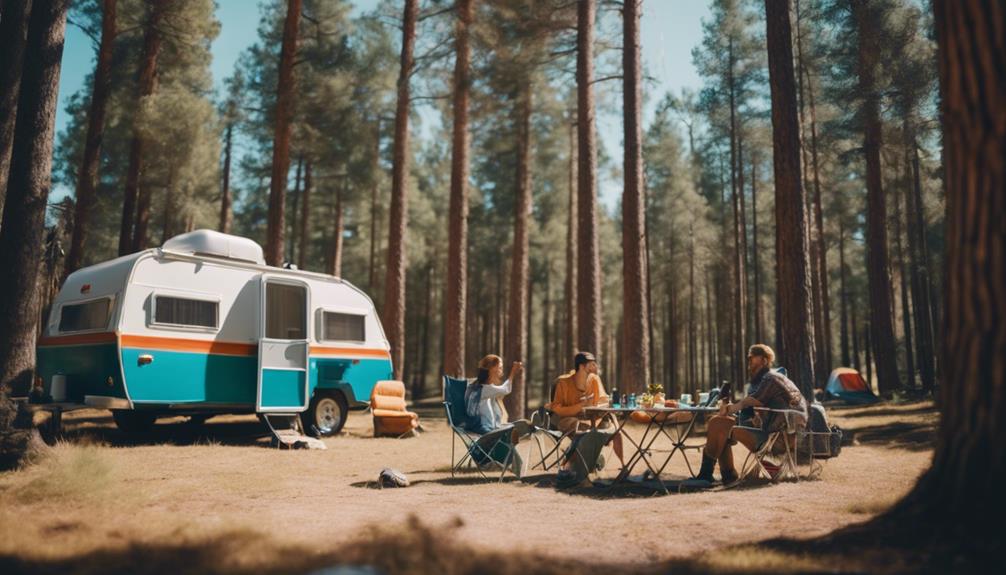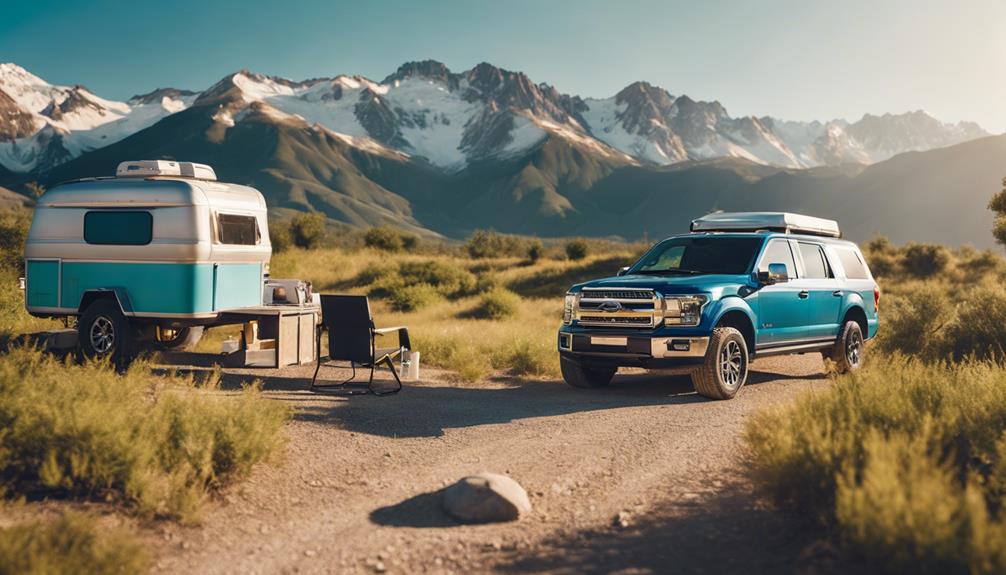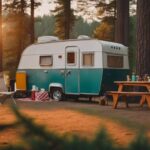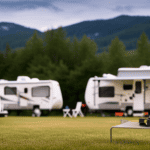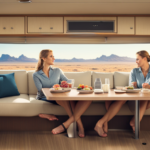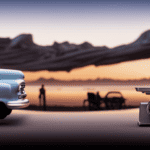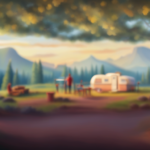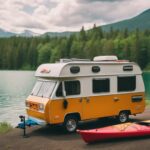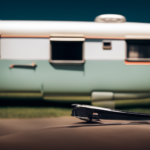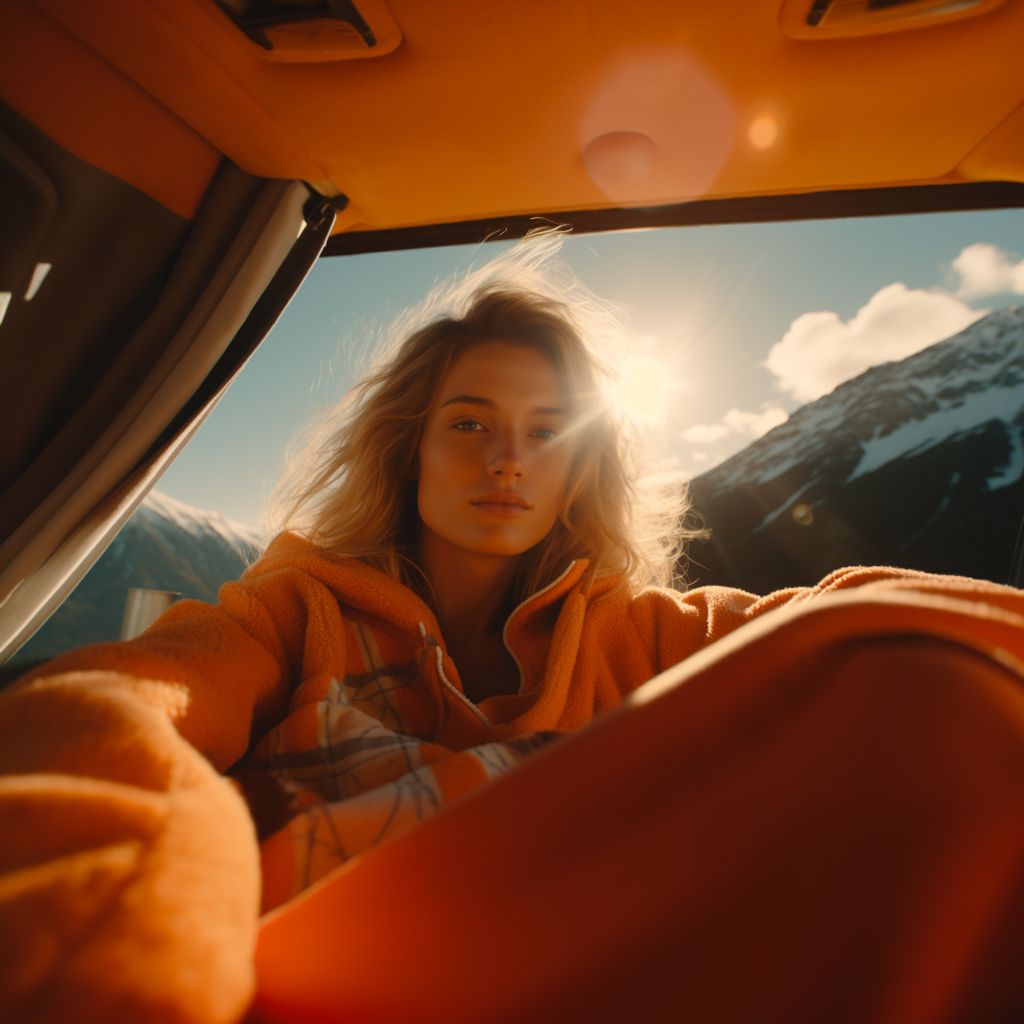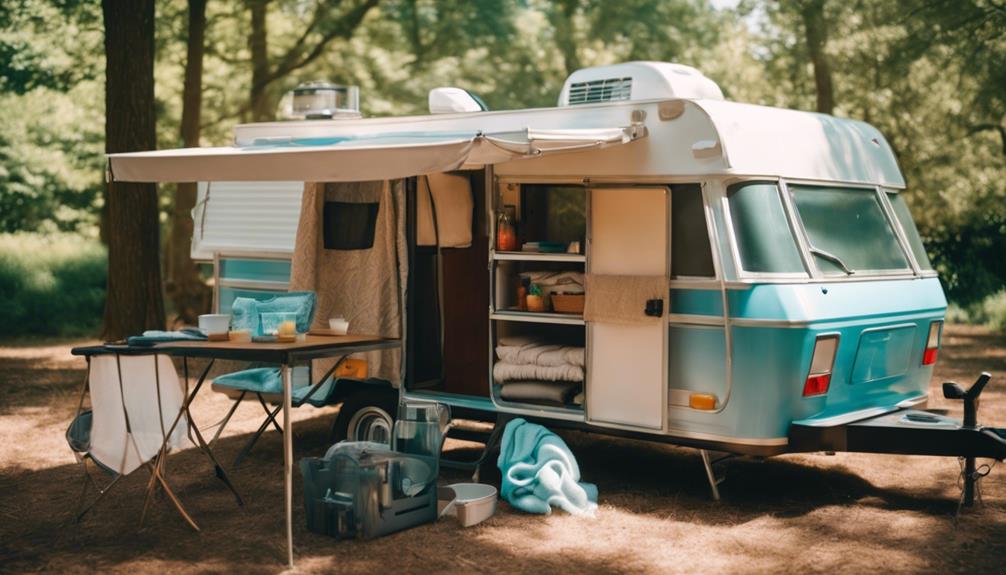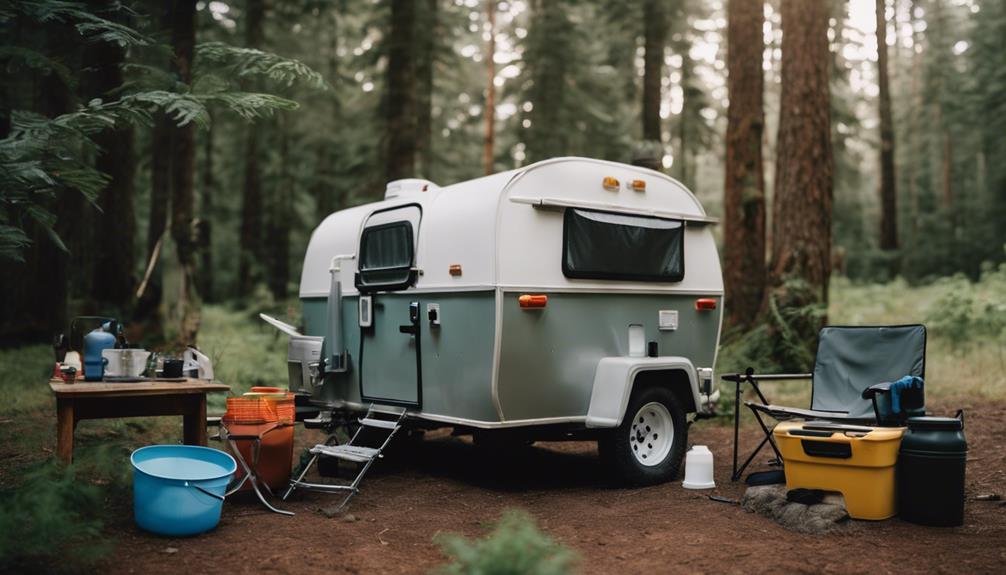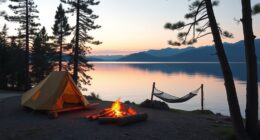Buying a pop-up camper can be exciting and rewarding. Start by setting a flexible budget that includes the purchase price and possible repairs. Check your vehicle's towing capacity to guarantee safe transport. Look for essential features like a propane stove, sleeping capacity, and a functional lift system. Inspect used campers thoroughly, checking for any damage, and always verify the title against the VIN. Don't forget to ask the seller about maintenance records. This way, you'll make a well-informed choice. There's much more to evaluate before you hit the road, so keep exploring your options!
Key Takeaways
- Verify ownership by checking the title against the VIN to ensure a clear transfer before purchasing.
- Assess your vehicle's towing capacity to guarantee safe handling of the pop-up camper.
- Set a flexible budget that accounts for the purchase price, repairs, and upgrades to avoid overspending.
- Look for essential features like a functional lift system, adequate sleeping capacity, and necessary amenities for a comfortable experience.
Important Buying Considerations
When buying a pop-up camper, it's important to take into account several key factors to guarantee you make an informed decision.
First, if you're considering a used pop-up camper, it's important to know that you should verify the title against the VIN and other documentation. This will help confirm a clear ownership transfer and avoid legal issues down the road.
Next, assess your vehicle's towing capacity. It's essential to choose a camper that your vehicle can handle safely. For instance, a Honda Pilot can tow up to 3,500 lbs, so make sure you know your vehicle's limits.
Setting a budget is also necessary. Don't just think about the purchase price; account for potential repair costs, upgrades, and any must-have features you want in your camper.
Key Features to Look For
After you've set your budget and considered significant factors, identifying key features in a pop-up camper will help guarantee it meets your camping needs.
Start by looking for essential amenities like a propane stove, sink, and refrigerator, making meal prep easier on your trips. Confirm the camper has enough sleeping capacity, ideally one to two pull-out beds in queen or king sizes, to accommodate your family comfortably.
Don't overlook the importance of a functional lift system; it's critical for raising the camper from its compact state to a livable space. If you're considering a used pop-up camper, pay close attention to the lift system's condition.
Another important aspect is the water hookup, which can enhance your camping experience by simplifying water access for cooking and cleaning.
Lastly, assess the storage space available. Look for under-bed storage and exterior weatherproof boxes to keep your camping gear organized and accessible.
Remember to evaluate the camper's overall weight to confirm it aligns with your vehicle's towing capacity for safe travel.
Finding and Inspecting Used Campers
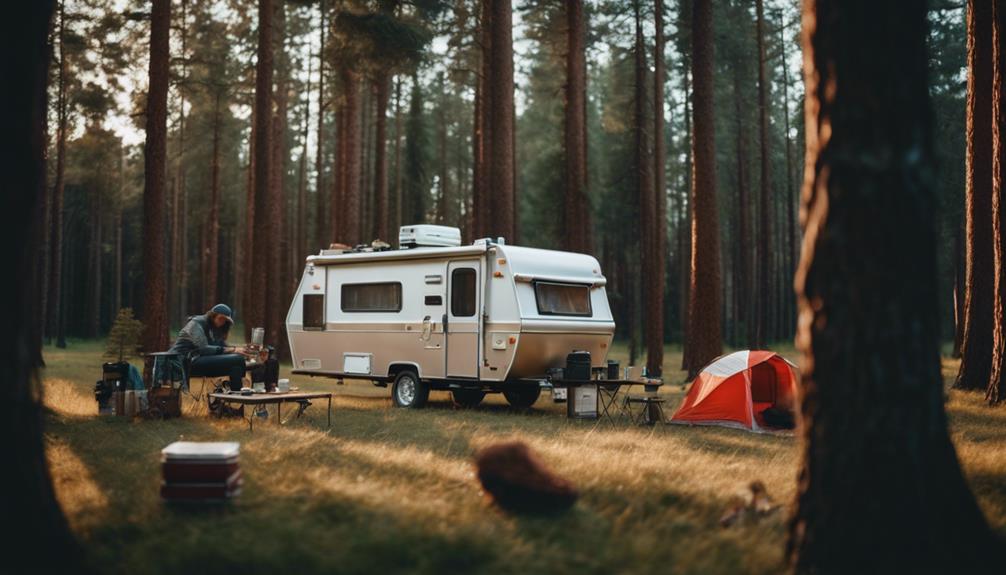
Start your search for a used pop-up camper by exploring platforms like Craigslist and local classifieds, while staying vigilant to spot potential scams.
When you find a listing that interests you, arrange to meet the seller in person to inspect the camper thoroughly.
During your inspection, check for soft spots in the floor and walls, as these can indicate water damage or rot, potentially leading to expensive repairs.
Don't hesitate to ask the seller for a complete setup and take-down demonstration to guarantee all components function properly and the camper operates smoothly.
Verify that the title matches the VIN, and ask for maintenance records to confirm the camper's history. A clean title free of liens is essential when purchasing a used camper.
Utilize a checklist during your inspection to cover all aspects, including the functionality of the lift system, appliances, and the condition of the tires.
This thorough evaluation will help you make a well-informed decision and avoid surprises down the road.
Finding and inspecting used campers can feel intimidating, but with careful attention, you'll increase your chances of a successful purchase.
Understanding Pricing and Budget
Understanding the pricing and budget for a pop-up camper is vital, as it helps you navigate the market and make informed decisions without overspending.
When you're buying a used camper, prices can vary widely. Smaller models may start around $1,500, while larger ones with more amenities can cost several thousand dollars. You might find the best deals in the fall and winter months when sellers are keen to offload their campers.
Consulting NADA Guides can provide a pricing baseline, but remember that local listings often reflect more realistic pricing due to regional differences. For instance, a 1996 Coleman pop-up camper could be snagged for as low as $500, showcasing the savings potential in the used market.
As a first-time buyer, it's important to set a flexible budget that accounts for the purchase price and any necessary repairs or upgrades. Prioritize essential features to avoid overspending on non-essentials.
Community Resources and Support
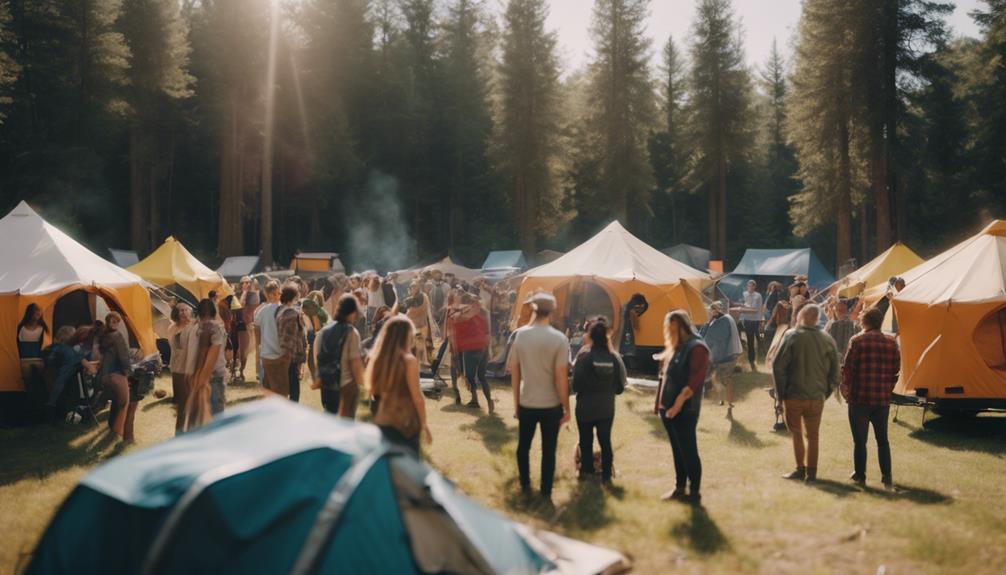
Engaging with community resources can greatly enhance your pop-up camper experience, providing support and valuable insights from fellow enthusiasts.
Online forums like PopUpPortal.com offer an excellent platform for first-time buyers to ask questions and share experiences. Here, you can find tips on everything from setup to storage, ensuring you feel confident with your new camper.
The Good Sam community is another great resource, allowing RV travelers to exchange advice and insights about camping trends and best practices. By participating in discussions, you can learn from experienced owners about common issues and DIY solutions specific to pop-up campers.
Additionally, many websites provide access to user manuals and guides, which can help you understand your camper's features and maintenance needs better.
Don't overlook local meet-ups and events organized by camping clubs, as these gatherings foster networking with fellow campers and create a supportive environment for new owners.
Maintenance and Upkeep Tips
To keep your pop-up camper in top shape, regular maintenance is key.
You'll want to inspect the roof, care for the canvas, and follow proper seasonal storage practices to avoid costly repairs down the road.
Staying proactive with these tasks guarantees a safe and enjoyable camping experience.
Regular Roof Inspections
Regular roof inspections are essential for keeping your pop-up camper in top condition and preventing costly water damage. To guarantee your camper remains functional, aim to conduct these inspections at least bi-annually.
Start by thoroughly inspecting the roof for any cracks, leaks, or damaged seals, particularly around corners and seams where water tends to collect. Pay special attention to areas around vents or air conditioning units, as these are common trouble spots.
During your inspection, look for soft spots or indentations on the roof surface. These could indicate underlying structural issues that may compromise your camper's integrity over time.
Don't forget to clean the roof regularly to prevent debris buildup, which can trap moisture and promote rot.
Additionally, check the caulking and sealants on the roof; if you notice any deterioration, reapply or replace them to maintain a watertight barrier.
Regular maintenance of your pop-up camper's roof not only extends its lifespan but also keeps it in good condition, allowing you to enjoy many more adventures without the worry of water damage.
Canvas Care Importance
Taking care of your pop-up camper's canvas is essential for preserving its integrity and guaranteeing your comfort during trips. Proper canvas care can save you from costly repairs and enhance your camping experience. Here are some key maintenance tips:
| Task | Frequency |
|---|---|
| Clean with mild soap & water | Every few months |
| Inspect for tears & wear | Twice a year |
| Apply waterproofing treatment | Every few years |
| Lubricate zippers | As needed |
Regularly clean the canvas to prevent mold and mildew buildup. During your biannual inspections, pay close attention to seams and edges for any tears or holes. Addressing these issues promptly will help avoid further damage. Every few years, apply a canvas waterproofing treatment to guarantee your camper repels water effectively. When your pop-up camper isn't in use, store it in a dry, covered area to protect the canvas from prolonged exposure to elements that can lead to deterioration. Finally, make sure all zippers and closures function properly; lubricate them to prevent sticking and potential damage.
Seasonal Storage Practices
Seasonal storage practices are vital for maintaining the longevity and functionality of your pop-up camper during the off-season. By taking the right steps, you can prevent water damage and guarantee your camper is ready for your next adventure. Here's what you should do:
- Clean and Dry: Before storage, thoroughly clean and dry your camper, focusing on the canvas and all interior surfaces. This helps prevent mold and mildew growth.
- Inspect and Maintain: Regularly inspect the roof caulking to make certain it's watertight. This is essential for preventing leaks and water damage while your camper is in storage.
- Proper Storage: Store your pop-up camper in a cool, dry place, ideally indoors or under a covered area. This protects it from harsh weather conditions and UV damage.
Remember to remove all perishables and personal items, including batteries, to deter pests.
Advantages of Pop-Up Campers
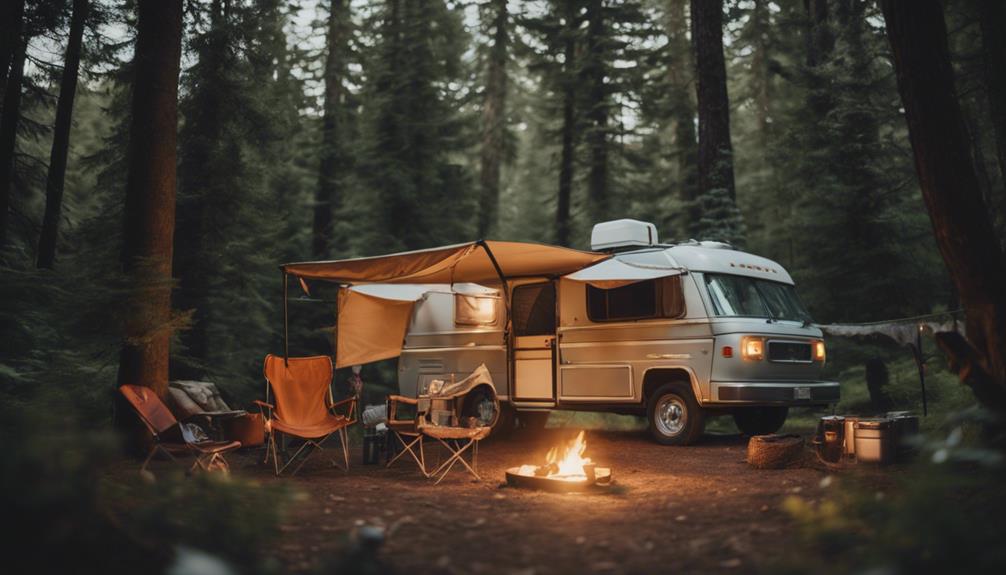
Pop-up campers offer a range of advantages, making them an ideal choice for budget-conscious campers seeking convenience and comfort. If you're considering your first camper, you'll find that pop-up campers are generally lighter and more aerodynamic than traditional RVs. This means they're easier to tow, increasing your fuel efficiency during travel—a significant perk for those on a budget.
Their compact design allows for easy storage in garages or driveways, unlike larger RVs that can require considerable space. When it comes to cost, pop-up campers provide a budget-friendly option, with prices typically ranging from $1,500 to several thousand dollars. This accessibility makes them a great choice for first-time buyers looking to avoid hefty investments.
Additionally, these campers offer versatile layouts that often include sleeping areas, kitchenettes, and storage solutions—perfect for families or small groups without sacrificing comfort. One of the must-haves for any camper is convenience, and pop-up campers can be set up in around 17 minutes. This speed allows you to kick back and enjoy your camping experience sooner, especially after a long day of travel.
Buying a used pop-up camper can further enhance your budget-friendly adventure.
Essential Questions to Ask
Before making a purchase, it's essential to ask the seller important questions that can help you gauge the camper's overall condition and suitability for your needs.
Here are three significant questions to take into account:
- Can I see the maintenance records? This will give you insight into the used pop-up's service history and any repairs made, helping you determine if it's been well cared for.
- What's the weight of the camper? Knowing the camper's weight is fundamental to confirm it falls within the towing capacity of your tow vehicle. This avoids potential safety issues when you're on the road.
- What's the condition of the important components? Inquire about the age and state of critical parts like the roof, canvas, and appliances. Understanding their condition can help you anticipate future repair costs.
Safety and Boondocking Practices
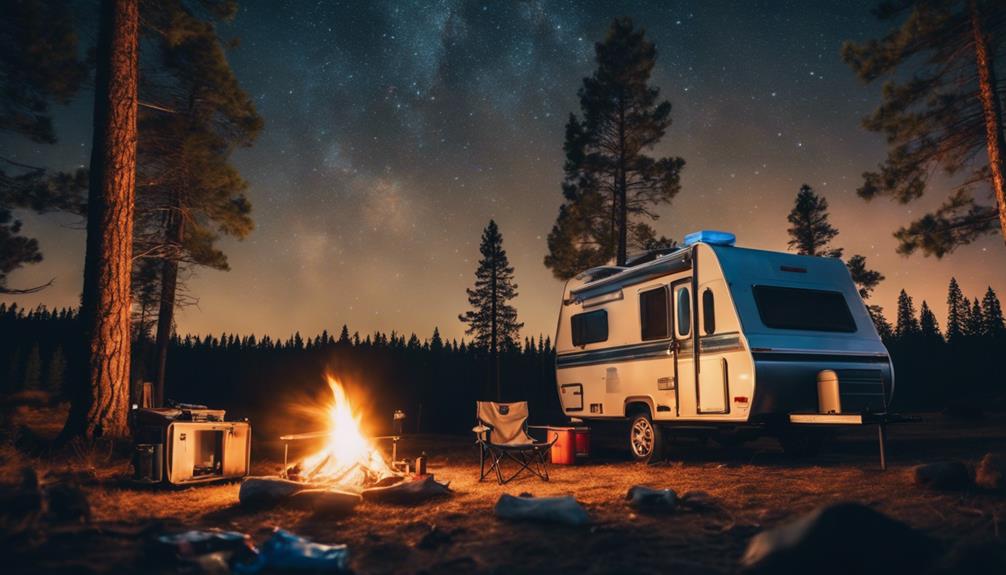
Safety is essential when boondocking, so always choose designated camping areas and stay aware of your surroundings to minimize risks.
When you're dry camping in remote locations, confirm you have a reliable communication method, like a satellite phone or personal locator beacon, for emergencies. Familiarize yourself with local wildlife behavior to avoid unwanted encounters. For example, store food securely and consider using bear-proof containers to keep wildlife at bay.
Before settling in, conduct due diligence by evaluating the campsite's accessibility and security. Assess the terrain, and check how close you're to emergency services, just in case. It's also wise to stay clear of wildlife trails, particularly in areas known for bears or moose.
Remember to practice Leave No Trace principles while boondocking. Pack out all waste and minimize your impact on the environment to preserve these beautiful natural habitats.
By taking these precautions, you can enjoy your camping experience while confirming your safety and that of the wildlife around you.
Happy camping!
Upgrades and Warranty Information
When you're considering a pop-up camper, understanding the warranty terms is essential to protect your investment.
You'll also want to think carefully about upgrades; while they can enhance comfort, safety should always come first.
Let's explore how to balance these aspects effectively.
Warranty Terms Explained
Understanding warranty terms is important for protecting your investment in a pop-up camper and ensuring you know what's covered and what's not. A solid warranty can save you from unexpected costs related to repairs, especially if you're buying a used camper.
Here are three key points to keep in mind regarding warranty terms:
- Coverage Duration: New pop-up campers usually come with limited warranties lasting from one to five years, covering structural components and major systems. Be sure to check the specifics.
- Exclusions: Many warranties exclude certain items, like appliances or cosmetic damages. Reading the fine print helps you avoid surprises down the road.
- Modifications: If you plan on upgrading or modifying your camper, be cautious. Some changes can void your warranty, particularly if they affect the camper's structural integrity or electrical systems.
It's also important to maintain and document any repairs you perform. This information can be significant for warranty claims and demonstrates adherence to warranty terms, enhancing your protection.
If you're considering a used camper, always ask about any remaining or transferable warranties for added peace of mind.
Upgrade Safety Considerations
Upgrading your pop-up camper can enhance your experience, but it's important to contemplate how these changes might impact your warranty and overall safety. Focus on cosmetic improvements that won't compromise the structural integrity of your camper. Major modifications can complicate repairs and pose safety risks down the line.
Before diving into any upgrades, verify your warranty coverage. Check with your dealer or manufacturer to confirm that the modifications won't void any existing warranties. This way, you can enjoy your upgrades without worrying about losing crucial protection.
When it comes to electrical upgrades, always hire qualified professionals. Improper installations can lead to serious safety hazards and future malfunctions. Additionally, assess the age and condition of key components like the lift system and appliances; these factors are fundamental in determining necessary upgrades for safety and functionality, especially in older models.
Lastly, keep thorough documentation of all upgrades and repairs. This record is essential for warranty claims and can greatly increase your camper's resale value in the future.
Frequently Asked Questions
What Time of Year Is Best to Buy a Pop-Up Camper?
The best time to buy a pop-up camper is during fall and winter. Prices drop as sellers want to sell before off-season. You'll find better deals and a wider selection during this period.
How to Choose a Pop-Up Camper?
When it comes to choosing a pop-up camper, don't bite off more than you can chew. Assess your towing capacity, list essential features, inspect for damage, and research reliable brands to guarantee a great camping experience.
What Do I Need to Know as a First Time RV Buyer?
As a first-time RV buyer, you need to know your intended use, evaluate size and layout, inspect for damage, understand specifications, and budget for ongoing costs. This guarantees a satisfying and enjoyable RV ownership experience.
What to Look for When Buying a Used Pop-Up?
Don't worry if you're unsure where to start; when buying a used pop-up, inspect the canvas, check the lift system, assess structural integrity, verify amenities, and review maintenance records to guarantee a great purchase.
Can Awning Setup Impact the Buying Decision for a Pop-Up Camper?
When considering a purchase, the quick setup popup camperawning can have a significant impact on the buying decision. Potential buyers are often drawn to the convenience and ease of setting up and taking down an awning, making it a valuable feature to consider when selecting a pop-up camper.
Conclusion
So, there you have it! Buying a pop-up camper isn't just about finding a cozy place to sleep; it's a rite of passage into the wild world of questionable decisions and overpriced gear.
Embrace the chaos, ask those essential questions, and remember, nothing says adventure like a 2 a.m. struggle with a crank handle.
So go ahead, jump into the world of camping with your shiny new pop-up—just don't forget the duct tape and a sense of humor!

